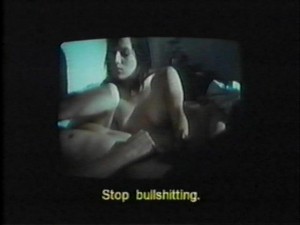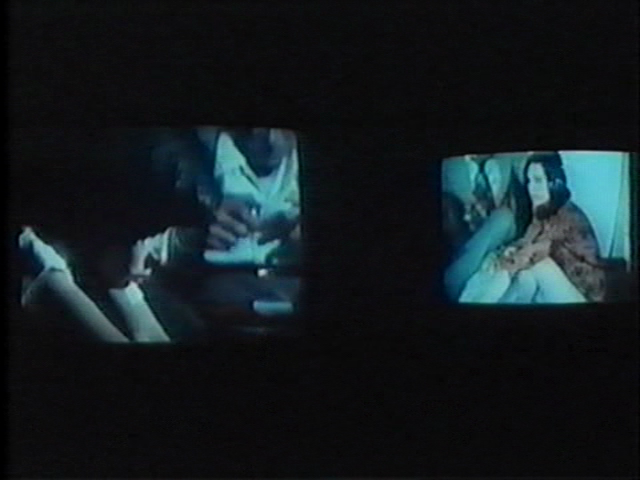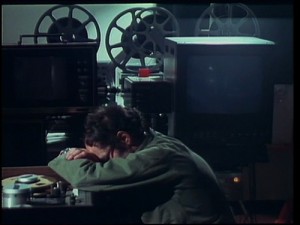From Sight and Sound (Spring 1976). –- J.R.
Numéro Deux
If Numéro Deux is the most important film of Jean-Luc Godard in nearly a decade — specifically, since 2 ou 3 Choses que je sais d’elle -– one should explain at the outset what gives these films privileged places within his oeuvre. Focusing in 35mm and wide screen on a fictional working-class family, both are essentially bound up in issues of representation, and neither allies itself to any organized political faction or has any links with the Dziga-Vertov Group and/or Jean-Pierre Gorin. The point of this distinction is that Godard’s pre-eminence has always stemmed directly from his grasp of the problems of representation — a line of inquiry leading from the jump-cuts of Breathless to the fragmented double-images of Numéro Deux -– and that his political commitments have always been inscribed within this concern; it is highly debatable whether he has contributed anything of value to political thought apart from this context. Yet broadly speaking, the increasing emphasis in his work after 2 ou 3 Choses — in La Chinoise,Weekend, 1 + 1, Le Gai Savoir and all the subsequent ventures — has until now been more on the ‘signified’ (subject) and less on the ‘signifier’ (manner of representation), away from investigation and towards didacticism.
The balance, to be sure, has usually been a delicate one, and one could argue that a reverse emphasis in 2 ou 3 Choses periodically threatens to annihilate the social subject and substitute Godard’s questioning consciousness as the focal point. But here at least the meaning of Godard’s narration is wholly dependent upon the accompanying images and sounds, while in works as diverse as Weekend, Le Gai Savoir, Vent d’est and Tout va bien, the central verbal discourses tend to take on a relative autonomy: to a certain extent, one can ‘explain’ these films simply by quoting from them.
In Numéro Deux, however, it is impossible to disengage the verbal elements from their contexts and retain any grasp of their assigned meanings — not only because much of the verbiage is unusually obscure, particularly in isolation from the other elements, but more centrally because the integrity of the image is challenged more basically here than before, thereby assigning the words a much more fluctuating and unstable role. Consider just a few of the strategies at work:
(1) The opening shot: on the left, a square of flickering red TV static; on the right, another square, more vertical, framing part of a man’s face, later replaced by a comparable view of a woman’s face. (They are the two leading characters/actors: Pierre Oudry and Sandrine Battistella.) Between the squares, and against the surrounding blackness, the words MON, TON and SON in a vertical column; opposite the latter word is IMAGE, and to the right of IMAGE, SON again — until the second SON is covered by a widening of the right square, revealing the rest of Pierre’s face, before receding again. Then IMAGE and SON flash on and off like neon signs, so that SON becomes alternately a personal pronoun (‘his/her’) and ‘sound’, depending upon which pair of words it attaches itself to. All these shifting co-ordinates help to establish an unsteady composite image whose ‘meanings’ are in a state of perpetual flux.
(2) Early in the film, Godard appears in his Grenoble studio — a full 35mm image –and delivers a monologue, standing on the right in profile and semi-darkness beside a TV screen which shows him more legibly head on. Shortly before the end, he reappears in the studio, sitting at a tape deck and set of sound controls on the left, while Sandrine continues an off-screen monologue; then she appears silently on a TV screen, overhead and further to the left, speaking but not in synch with her monologue; to the right, on the other side of Godard, her daughter Vanessa appears on another TV screen, and his gaze is diverted in her direction.
(3) More often, we are simply presented with two images at once against a black background — either adjacent TV-like squares of varying sizes or one image superimposed over another within a single square. On certain occasions, the latter technique permits an innovatory use of simultaneous reverse angles, so that we see Sandrine, for instance, turned away from the camera in a long shot that is overlapped by a negative close-up of her looking towards another camera.
Generally speaking, the notion of reverse-angles is central to Godard’s ethical position: since Sandrine and her family primarily view the ‘world outside’ (us) through a TV screen — and significantly, the only time we see them all in one frame is when they’re grouped around an off-screen set — the tactics of his method are to reverse this procedure.
(4) The sound-mixing is comparably disruptive, with various verbal and non-verbal tracks repeatedly overtaking, supplanting, interrupting and contesting one another; and much as the visual duplications refer back to TV, the aural separations are explicitly connected to the use of ” earphones by various members of the family, with songs by Léo Ferré playing an especially important role. At no point do these devices become programmatic, because their functions shift at every turn, with duplications, variations and contrasts assuming fresh roles of signification in relation to the overall complex of elements.
‘They say “Once upon a time,”‘ Sandrine remarks at one point. ‘Why not “Twice upon a time” ?’ Dualisms of various sorts-sound and image, documentary and fiction, male and female, ‘chance’ and ‘necessity’ — have always been essential to Godard, but here he takes the process a crucial step further. With one image and soundtrack to present or interrogate, he can attack his material like a theorem: one image of a person is an emblem, a sign, a signifier, an arbitrary block of space and time (‘chance’)which automatically becomes a postulate (‘necessity’). But two contrary images of the same person at the same time — a procedure already familiar in Cubism — undermines the status of each as a premise. Thus with the absence of any fixed reference point or narrative guide, everything is thrown open to question, including the questions themselves, creating a perpetual passage into and out of meanings that is kept consistently interesting by Godard’s wealth of invention. It is only during two extended monologues by the grandfather, when sound and image become momentarily singular, that the film threatens to grind to a halt.
I have deliberately postponed a discussion of the film’s ‘subject matter’ in order to establish first the peculiar conditions under which this material is approached. A return to 2 ou 3 Choses may serve as a helpful contrast: while the earlier film has a plot (however putative), a paraphrasable theme and a carefully defined trajectory and fictional time-span, the new film offers no such comforts or signposts. All the action is centered round the family flat (even the few exteriors seem to be shot from windows), and the framing is often ‘intimate’ to the point of ellipsis, with actors and rooms usually caught only in fragments. On the other hand, considerable stress is placed on certain factors that the former film rigorously excluded — above all, the body and its functions. Much is made of Pierre’s impotence and Sandrine’s constipation, and all three of the family’s generations are presented in terms of their sexuality. If the overall ambience of this emphasis often seems as puritanical as the reticence of earlier Godard, the intention is nevertheless clear: to represent such subjects as the everyday matters they are,without any trappings of conventional eroticism, and to examine the points of contact between these concerns and ‘political’ relationships within and outside the family unit.
Thus while Sandrine remarks off-screen, ‘Not a film of the left or right, but a film before and behind — before is children, behind is government,’ the screen shows Vanessa’s face superimposed over an image of intercourse, Pierre entering Sandrine from behind. Clearly this can’t be read as a simple joke or statement of equivalences, but several potential ‘cells’ of meaning interact: Pierre governs Sandrine, the government ‘screws’ them both, a child derives from their sex together; only later does this juxtaposition become justified in narrative terms, when we’re told that Vanessa witnessed their intercourse, so that in a repeat of this shot we read the close-up as a reverse-angle. Elsewhere, the couple give a sex lesson to Vanessa and her brother Nicolas, and when Pierre compares their organs to lips and their intercourse to talking, Vanessa protests that the act is mute — recalling the metaphors of sex and language in Godard’s brilliant (and neglected) short Anticipation, which also contested the assurances of a single integral image by situating this postulate in the realm of Utopia.
Not incidentally, it is worth noting that in many scenes, sexual and otherwise, a warmth between the characters is conveyed that has been conspicuously absent from Godard’s other work over the past decade. More characteristically, the aim may be ‘scientific’ but the methods are generally ‘poetic’ and intuitive, usually reaching for the evocative metaphor rather than the precise one. In another sex scene Sandrine sits on Pierre’s chest, facing away from both him and the camera while complaining about what she can’t see. ‘My mouth sees for you,’ Pierre says, and when she asks him what he sees, he begins, ‘Your body is like a river…’
A self-parody of the Godard method? Perhaps; and there are many such moments. But even here, the notion of one image impinging upon another (in this case, an unseen reverse-angle) remains essential. And puns and metaphors play an analogous role throughout. The question is raised whether Sandrine is a factory or a landscape-an electrical factory with charges and discharges, producing babies and meals, or a spectacle to look at, a part of society? When you go to a film, she declares, ‘you sell out to the producer. Turn on the television and you become an accomplice. . .You’re looking for news about yourself when what you see is news about others.’
Which is Numéro Deux? Sandrine delivers these words on a TV screen being watched byGodard: does that make him an accomplice ? A stand-in for neither the characters nor the spectators but a mediator between these distant worlds, he occupies a distinct darkness of his own — an extension of the blackness surrounding TV screens and cinema screen alike, contiguous with both, identical to neither. All three forms of darkness suggest a womb in which meanings are spawned. ‘Before I was born, I was dead,’ Vanessa copies on a blackboard. ‘Do all little girls have holes?’ she asks her mother while taking a bath. ‘Is that where memories come out?’ Simultaneously destructive and constructive in its flight back to zero, Numéro Deux situates the loss of memory and the birth of signification on the same dark and slippery but fertile terrain — a factory-landscape where anything becomes possible.
JONATHAN ROSENBAUM





